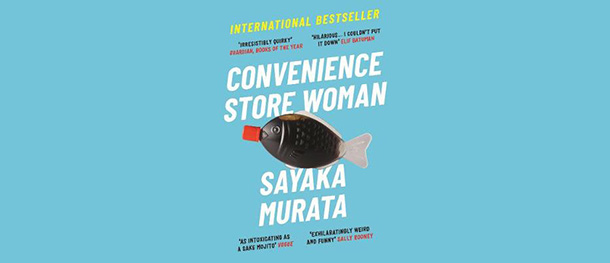Review: Convenience Store Woman
‘Convenience Store Woman’ by Sayaka Murata.
A review by Megan Robinson.
Convenience Store Woman is an international bestseller, with raving reviews from the likes of Sally Rooney and Vogue. It is a short novella (only 163 pages) and you have the choice of three different coloured covers: yellow, blue and pink. (I chose yellow.) The book follows Keiko, she’s 36 years old, she’s never had a boyfriend and she’s been working in the same convivence store for eighteen years. Her parents wish she’d get a better job. Her friends wonder why she won’t get married. But Keiko knows what makes her happy, and she’s not going to let anyone take her away from her convenience store.
I picked up this book because whilst I was attending The University College of London’s ‘Introduction to Publishing’ course, I met the team behind the marketing of this book when it was originally released (in the UK) IN 2018. In a Waterstones in London, they made a makeshift Japanese vending machine out of cardboard and displayed the various coloured covers in it, to make it looks like a convenience store vending machine. I was so impressed by this marketing tactic alone that I decided to buy a copy of the book.
With it being such a short book, I finished it in about an hour. Keiko’s descriptions of the convenience store are so descriptive, rigid but also otherworldly, that it makes you think differently about how you could perceive a convenience store. The reason for this may be because the author, Sayaka Murata spent eighteen years working part-time in a convenience store herself (just like Keiko) before the success of this book. Whether this is the only similarity between her and her protagonist, I am not aware.
Throughout the novel, it is very obvious that Keiko has some form of autism, although it is not directly stated. Like many people who have autism, Keiko has a routine that she follows and ‘masks’ to ‘fit in’ and seem normal. ‘Masking’ is a common trait amongst many people with autism when they become aware that the way they behave/react to situations is seen as abnormal. Keiko learns to mask during her childhood when she takes situations too literally and becomes confused by others reactions to situations (ie the dead pigeon.) She is then shown to be adopting different masks in different situations, taking on her supervisor’s characteristics at work and her friends around them. She is aware that this isn’t how she wants to react, but knows that she has to do it if she wants to appear ‘normal.’ Shiraha is another character, who I believe, has some form of autism, but he has high functioning autism. He knows exactly what to say/do around other people (ie when Keiko’s sister came to visit) but he also has a strange yet very specific fascination with comparing society to cavemen times. He is an example of someone with autism who doesn’t want to interact with the outside world, and therefore exploits Keiko to achieve his goals (although she sees their fake relationship as beneficial as it helps her to appear more normal to her friends and family.)
I haven’t done much research into Japanese society’s views on autism, but if I were to base it on this book alone I would have to say it appears that there are not very understanding/aware of it. Keiko is never described as having autism or being diagnosed with it, but it’s clear she probably has some form of it. All of her friends and family (especially her sister) find her behaviour and the way she acts as strange and will often call it out to her. At one point Keiko’s sister breaks down to her, saying she wishes that Keiko was normal and that she should attend therapy to ‘become normal.’ All of this pushes the idea that perhaps Japanese society is not so understanding of autism. I wish that Murata had stated that Keiko does have autism as this book would be an interesting commentary of how people with autism are still seen as ‘abnormal’ by society, and that if they don’t fit to mould they have formed (progress in your career, get married, have a family) then you are ostracised.
It is perhaps also hinted that Keiko is asexual as she says she has never had sex and has never had an interest in it, but again this is not specifically said but implied. (This was also featured in Mieko Kawakami’s ‘Breasts and Eggs.’) Again, for this Keiko is questioned and seen as strange, she is questioned which makes Keiko uncomfortable. This also makes the fake relationship with Shiraha more appealing to her; when people believe they are a couple the people in her life (co-workers, friends, family) seem relieved because she has fit their mould of what a person should be.
Overall, Convenience Store Woman is a unique short read, and if you are a fan of Japanese literature I recommend you read this. With its unique voice and imagery, it’s an enjoyable read. The only question left is, which coloured cover will you pick?
4/5 stars.
Review by Megan.







